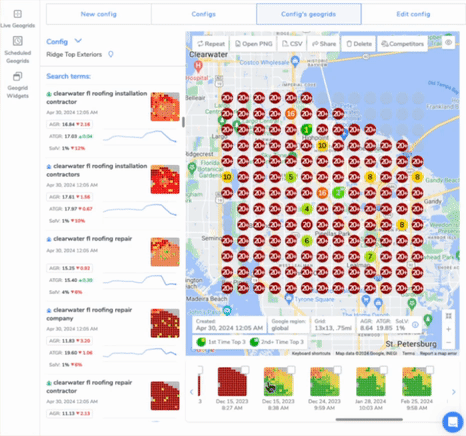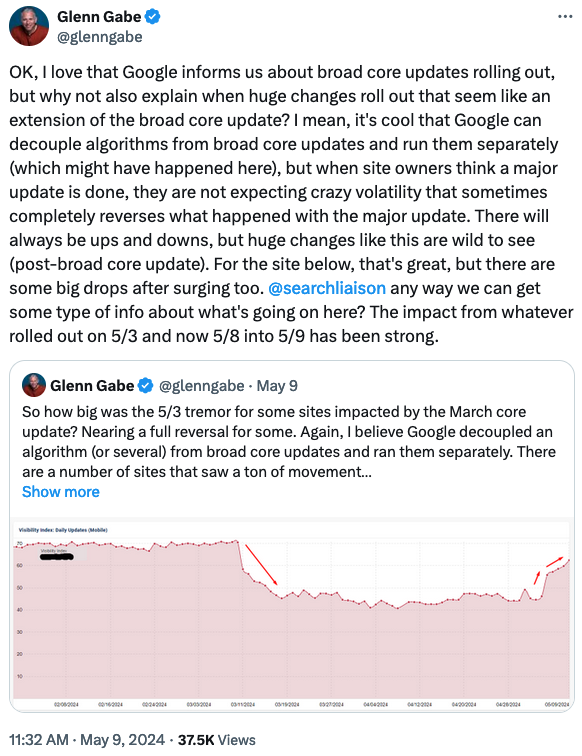Hey folks. We hope all of you are doing what you can to stay safe while the sun hurls tons of modernity-wrecking space rays toward the earth. One of our European colleagues lost his internet connection for ~10 minutes this morning. We knew we couldn’t take any chances after that, so we spent the following two hours massaging SPF 100 sunblock onto the surfaces of our electronic devices (we’d probably cry if our TP-7 got messed up). The fact that you’re reading this newsletter is evidence that our plan is working.
It’s time to talk about new GeoGrid features. You’ll probably be able to find most of the new stuff we’re building on other Business Profile management platforms by this time next year, but we’re adding functionality faster than our competitors can copy it for the time being. Let’s take a look.
 That’s our comparison feature. Local Viking and Local Brand Manager users can check it out by navigating to any scheduled GeoGrid search configuration, picking a search term, and choosing two results from the timeline. When you see the blue “view comparison” button pop into existence, click on it to spin up a comparison page that can be viewed by anyone, anywhere.
That’s our comparison feature. Local Viking and Local Brand Manager users can check it out by navigating to any scheduled GeoGrid search configuration, picking a search term, and choosing two results from the timeline. When you see the blue “view comparison” button pop into existence, click on it to spin up a comparison page that can be viewed by anyone, anywhere.
 There’s new SEO Mad Scientist data that you can read up on in the recurring section below. For any of you who didn’t check it out last time, it’s a project that our cousins at Web 20 Ranker are carrying out that tests what is and isn’t effective when it comes to helping businesses improve their visibility and rankings. The experiments and resulting data will change as time goes on, so your best bet is to check on the updates every week.
There’s new SEO Mad Scientist data that you can read up on in the recurring section below. For any of you who didn’t check it out last time, it’s a project that our cousins at Web 20 Ranker are carrying out that tests what is and isn’t effective when it comes to helping businesses improve their visibility and rankings. The experiments and resulting data will change as time goes on, so your best bet is to check on the updates every week.
We ran into an interesting article on Search Engine Journal that is spreading the word about the fact that organic volatility is in no way confined to the core updates that Google periodically announces. The article itself is primarily based on the tweet that you see above this paragraph and the response it received from Danny Sullivan, the man running the @searchliasion X account.
To boil things down as much as possible, we’ve got Glenn Gabe asking why he’s seeing so much traffic chaos when there’s not an ongoing core update and things should, in theory, be pretty calm. The response is that Google makes Search updates around 5,000 times per year, and many such tweaks are not announced. We’d be looking at around 15 announcements per day that said things like “made an adjustment to system 44,” and “updated system 226” if the public were truly kept in the loop about every change Google makes.
Our first closing link comes from The Wall Street Journal and it ties into an article we linked to at the end of our April 19 newsletter about variable pricing snaking its way into all goods and services. The title of the WSJ piece is The Gap Between the Price You See and What You Pay Is Getting Worse. The self-explanatory headline tells the tale of add-on fees running wild nowadays. Next, we’ve got a post on the Later blog that explains how to spot (and block) fake Instagram accounts. Up third: a Hootsuite guide to the people who still actively use Twitter/X called 19 X (Twitter) Demographics for Marketers in 2024. Finally, I regret to inform you that LinkedIn’s games are very fun from The Verge will be of interest to the Wordle fans in our audience. It appears that LinkedIn executed their foray into the daily-changing game arena quite well.
That’s what we have for you today. Be safe this weekend.

